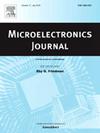Design and implementation of a charge-sharing in-memory-computing macro with sparse feature for quantized neural network
IF 1.9
3区 工程技术
Q3 ENGINEERING, ELECTRICAL & ELECTRONIC
引用次数: 0
Abstract
With the rapid development of artificial intelligence technology, in-memory computing has become a research hotspot. In this article, we propose an in-memory computing (IMC) architecture that achieves high energy efficiency and performance. Our work is based on the working mechanism of charge sharing, enabling configurable multi-bit Multiply-Accumulate operations. This work employs a unique bit-cell structure to implement sparse strategies at the bit-level in IMC arrays and compensates for errors caused by non-ideal effects, thus achieving better energy efficiency and performance. A hardware-aware quantification method and a hardware simulation model based on Pytorch have been proposed to evaluate the hardware mapping and compare with other charge domain IMC works. The MNIST and CIFAR-10 datasets have been used to validate algorithm models and chip performance, achieving accuracy rates of 97.6% and 90.5% respectively. The IMC chip was fabricated with a 180 nm CMOS process. The measurement shows that the chip achieves an energy efficiency of 41.8 TOPS/W.
为量化神经网络设计和实现具有稀疏特征的电荷共享内存计算宏
随着人工智能技术的飞速发展,内存计算已成为研究热点。本文提出了一种内存计算(IMC)架构,可实现高能效和高性能。我们的工作基于电荷共享的工作机制,实现了可配置的多位乘累加操作。这项工作采用独特的位元结构,在 IMC 阵列的位元级实施稀疏策略,并补偿非理想效应造成的误差,从而实现更高的能效和性能。为了评估硬件映射并与其他电荷域 IMC 作品进行比较,提出了一种基于 Pytorch 的硬件感知量化方法和硬件仿真模型。MNIST 和 CIFAR-10 数据集用于验证算法模型和芯片性能,准确率分别达到 97.6% 和 90.5%。IMC 芯片采用 180 纳米 CMOS 工艺制造。测量结果表明,该芯片的能效达到了 41.8 TOPS/W。
本文章由计算机程序翻译,如有差异,请以英文原文为准。
求助全文
约1分钟内获得全文
求助全文
来源期刊

Microelectronics Journal
工程技术-工程:电子与电气
CiteScore
4.00
自引率
27.30%
发文量
222
审稿时长
43 days
期刊介绍:
Published since 1969, the Microelectronics Journal is an international forum for the dissemination of research and applications of microelectronic systems, circuits, and emerging technologies. Papers published in the Microelectronics Journal have undergone peer review to ensure originality, relevance, and timeliness. The journal thus provides a worldwide, regular, and comprehensive update on microelectronic circuits and systems.
The Microelectronics Journal invites papers describing significant research and applications in all of the areas listed below. Comprehensive review/survey papers covering recent developments will also be considered. The Microelectronics Journal covers circuits and systems. This topic includes but is not limited to: Analog, digital, mixed, and RF circuits and related design methodologies; Logic, architectural, and system level synthesis; Testing, design for testability, built-in self-test; Area, power, and thermal analysis and design; Mixed-domain simulation and design; Embedded systems; Non-von Neumann computing and related technologies and circuits; Design and test of high complexity systems integration; SoC, NoC, SIP, and NIP design and test; 3-D integration design and analysis; Emerging device technologies and circuits, such as FinFETs, SETs, spintronics, SFQ, MTJ, etc.
Application aspects such as signal and image processing including circuits for cryptography, sensors, and actuators including sensor networks, reliability and quality issues, and economic models are also welcome.
 求助内容:
求助内容: 应助结果提醒方式:
应助结果提醒方式:


